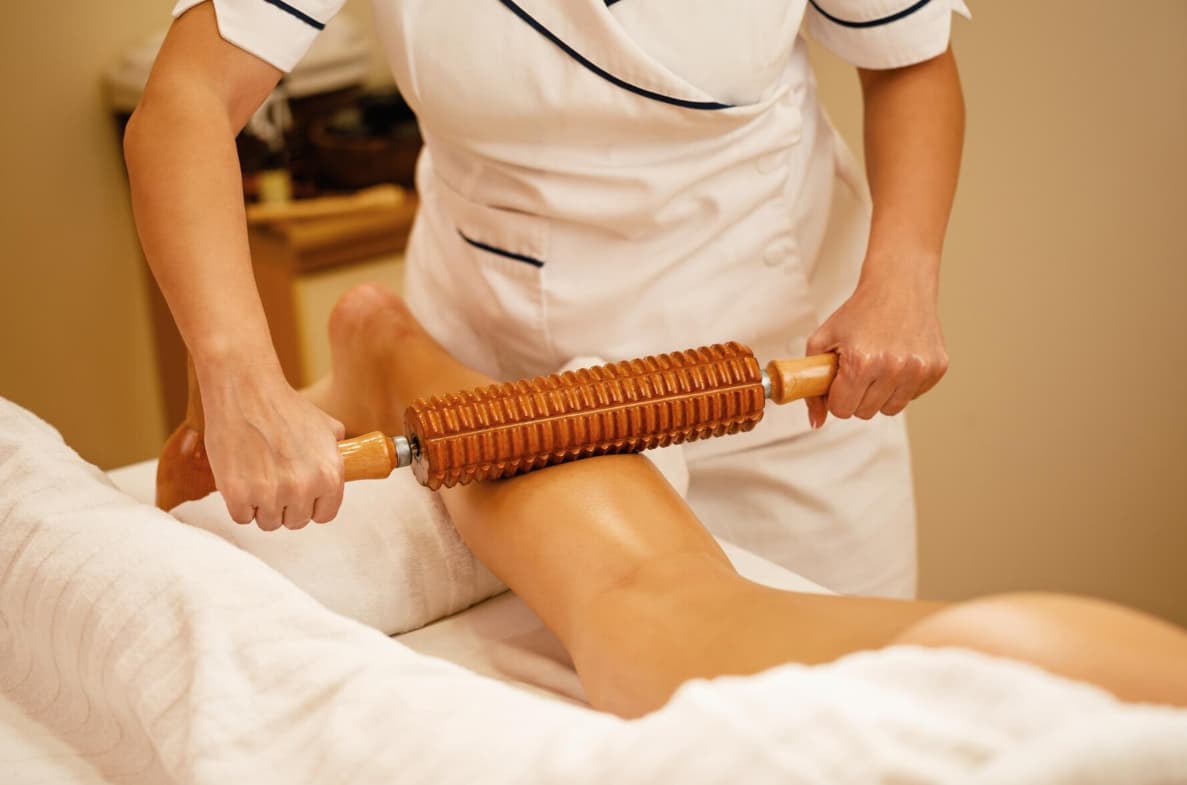Wood therapy, also known as maderotherapy or maderoterapia, is a type of massage that uses special wooden tools.
It’s a fairly new treatment in the world of wellness and beauty. People who do wood therapy say it can help with things like getting rid of fat, making your skin look smoother, and helping you relax.
The main idea behind wood therapy is that using these wooden tools on your body can break up fat, help your blood flow better, and make your skin look nicer.
Some people also think it can help reduce stress and make you feel more relaxed.
It’s important to know that wood therapy isn’t something that scientists have studied a lot. Most of what we know about it comes from the spas and clinics that offer it, not from big medical research centers.
This means we can’t be sure about how well it works or if it’s safe for everyone.
Wood Therapy

In this article, we’ll talk about what wood therapy is supposed to do, whether it actually works, and other ways people try to deal with things like cellulite (those little dimples some people get on their skin).
We’ll use simple words and explain things clearly so everyone can understand.
What Does Wood Therapy Do?
People who offer wood therapy say it can do a lot of good things for your body. Let’s look at some of the main things they claim it can do:
- Break down fat and cellulite: They say the wooden tools can help break up fat under your skin, including cellulite.
- Reshape your body: Some claim it can help change the shape of your body.
- Help your body clean itself: They believe it can help your body get rid of waste.
- Improve how your skin looks: It’s supposed to make your skin look firmer and smoother.
- Help you relax: Like other types of massage, they say it can help reduce stress.
- Loosen tight muscles: The wooden tools are meant to help relax your muscles.
- Make your legs and butt firmer: Some say it can help tone these areas.
- Boost blood flow: They claim it can help your blood move around your body better.
It’s important to remember that while these claims sound good, there isn’t scientific proof to back them up yet. Let’s look at some of these claims in more detail:
-
Reducing Cellulite
Wood therapy practitioners say their tools can break down fat and cellulite. They believe they can then move this broken-down fat to places where your body can get rid of it more easily.
While we don’t have proof that wood therapy itself does this, we do know that other types of massage can sometimes help with cellulite. These massages often use tools that look a bit like the ones used in wood therapy. They usually work by kneading the skin, sometimes using suction or a roller.
If these messages do make cellulite look better, it’s probably only for a short time. The smoother look might be because the massage causes a little bit of swelling in the area.
-
Helping Your Lymph System
Your lymph system is part of how your body fights off sickness. It’s made up of special tubes, nodes, and organs that move a fluid called lymph around your body. Lymph has white blood cells in it that help fight infections. It also helps get rid of extra fluid and waste from your body.
There’s a special kind of massage called manual lymphatic drainage that’s meant to help your lymph move around better. Wood therapy is different from this, but people who do wood therapy say it can also help your lymph system work better.
-
Reducing Stress
We know from studies that regular massage from a trained massage therapist can help people feel less stressed. People who do wood therapy say their massage can do the same thing.
Is Wood Therapy Effective?
The big question is: Does wood therapy work? The honest answer is that we don’t know for sure.
Scientists haven’t done studies on wood therapy yet, so we can’t say for certain if it does what people claim it does.
When people say wood therapy helped them, it’s based on their personal experience, not on scientific proof.
Wood therapy might have some of the same good effects as other types of massage that have been studied more. But we need more research to know for sure.
Here’s what we do know about massage in general:
- It can help loosen tight muscles
- It can increase blood flow
- It might help your lymph system work better
- It can help reduce stress hormones like cortisol
- It can make you feel more relaxed
- It might improve how your skin looks
- It can make you feel happier by increasing a hormone called serotonin
- It can help soften tight tissues in your body
While these benefits are true for massage in general, we can’t say for sure that wood therapy does all these things. More research is needed to know if wood therapy has these same benefits.
What to Expect at a Wood Therapy Session?
If you decide to try wood therapy, here’s what you might experience:
- The therapist will use special wooden tools on different parts of your body.
- They’ll move the tools in repetitive motions on areas like your face, chest, arms, and legs.
- They’ll press firmly and continuously on areas you want to work on.
- The tools are cleaned between uses to keep things hygienic.
It’s normal for the first few sessions to feel a bit uncomfortable. You and your therapist will work together to figure out how much pressure feels right for you. Over time, the sessions might start to feel more comfortable.
Important note: Some people might get bruises from wood therapy. It’s a good idea to talk to your doctor before trying it, especially if you have any health concerns.
Other Ways to Reduce Cellulite
Since many people try wood therapy to deal with cellulite, let’s talk about cellulite and other ways to treat it.
What is cellulite?
Cellulite is very common. About 85% to 90% of adult women have it. It’s those dimples or “orange peel” look you might see on your skin, usually on your thighs or buttocks.
Cellulite happens because of how the fat under your skin is structured. There are tough bands that connect your skin to the muscle underneath. Sometimes these bands pull down unevenly, which makes the fat push up in some places, creating that dimpled look.
Medical Treatments for Cellulite:
Several medical treatments aim to reduce cellulite. None of them can get rid of cellulite completely or forever, but they might help it look less noticeable. Here are some options:
- Acoustic wave therapy
- Uses sound waves to break up tough tissue
- Might help reduce how cellulite looks
- Usually needs several treatments
- Carboxytherapy
- Puts carbon dioxide gas just under your skin
- Early studies show it might help
- Can be uncomfortable and might cause bruising
- Cryolipolysis (Cool Sculpting)
- Freezes unwanted fat
- Can help get rid of small pockets of fat
- Doesn’t treat cellulite
- Laser treatment
- Different types available
- One type (Cellulaze) breaks up tough bands under the skin
- Might reduce cellulite for a year or more
- Often only needs one treatment
- Radiofrequency
- Uses heat energy on the target area
- Some devices combine this with laser, suction, and massage
- Might give a small, temporary reduction in cellulite
- Usually needs several treatments
- Subcision (Cellfina)
- Uses a needle to break up tough bands under the skin
- Has been shown to reduce dimpling
- Results can last 2-3 years
- Can cause temporary swelling and bruising
- Ultrasound
- On its own, hasn’t been shown to reduce cellulite
- When combined with other treatments, might have a small effect
- More research is needed
Home Remedies for Cellulite:
Some people try home remedies for cellulite. Here’s what we know about a few common ones:
- Apple cider vinegar: There’s no good evidence that it helps with cellulite, whether you drink it or put it on your skin.
- Caffeine creams and scrubs: Products with caffeine might make cellulite look less obvious for a short time by drying out the cells. You’d need to use them every day to keep seeing results.
- Dry brushing: This means brushing your dry skin with a special brush. There’s no research showing it helps with cellulite.
- Exercise: While exercise won’t get rid of cellulite, it can help build muscle. This can make your skin look smoother and firmer, which might make cellulite less noticeable.
Other Therapies for Cellulite:
- Endermologie
- Uses a device that massages your skin and lifts it with suction
- The FDA says it probably won’t hurt you, but they haven’t said it works
- You need several treatments
- Studies disagree on whether it works or not
- Retinol creams
- Creams with 0.3% retinol might make your skin thicker, which could reduce how cellulite looks
- You need to use it for at least 6 months to maybe see results
- We need more long-term studies to be sure
- Other creams and lotions
- Most aren’t worth the money
- Some medical-grade products might slowly help your skin make more collagen, which makes it firmer
- Always test a new product on a small area first
- Be careful with products that contain aminophylline – they can cause anxiety or a racing heart, and people with asthma should avoid them completely
Summary:
Wood therapy is a type of massage that uses special wooden tools. People who do it say it can help with things like reducing cellulite, improving blood flow, and helping you relax. However, we don’t have scientific proof that it does these things.
Other treatments have been studied more and shown to help a bit with cellulite, but none can get rid of it completely. These include things like certain types of laser treatments, radiofrequency, and special massage techniques.
If you’re thinking about trying wood therapy, it’s important to remember that we don’t know much about how safe or effective it is.
Unlike massage from a registered massage therapist, wood therapy hasn’t been studied enough. While some people say it has helped them, we can’t be sure it will help everyone or that it’s safe for everyone.
Before you try wood therapy, make sure to:
- Do some research on the person offering the treatment
- Ask lots of questions
- Talk to your doctor, especially if you have any health concerns
Remember, there’s no magic cure for cellulite. The best things you can do for your overall health and appearance are to eat a balanced diet, exercise regularly, and take good care of your skin.
FAQs:
- Does wood therapy work for the butt?
People who do wood therapy say it can help reduce cellulite on the butt and make it look firmer. But we don’t have scientific proof that it does this.
- What is a butt lift with wood therapy?
Some wood therapy practitioners say their treatment can give your butt a natural lift. This might involve using wooden cups to create suction. But again, there’s no scientific proof that this works.
- Does wood therapy break up fat?
Wood therapy practitioners claim it can break up fat, but this hasn’t been proven by scientific studies.
- Does wood therapy cause bruising?
Yes, wood therapy can cause bruising for some people. That’s why it’s important to talk to your doctor before trying it, especially if you have any health concerns or take medications that might make you bruise more easily.
Sources:
Here are the sources used for this article:
- KBH Training Academy. Wood therapy aka maderoterapia.
- Chasing Maria. 10 common questions about wood therapy body contouring.
- American Board of Cosmetic Surgery. Cellulite treatments.
- American Massage Therapy Association. Go with the flow: manual lymphatic drainage.
- National University of Health Sciences. Top 5 health benefits of regular massage therapy.
- BetterHealth. Massage.
- The Dermatologist. The cellulite treatment toolbox.
- Bervoets DC, Luijsterburg PA, Alessie JJ, Buijs MJ, Verhagen AP. Massage therapy has short-term benefits for people with common musculoskeletal disorders compared to no treatment: a systematic review. Journal of Physiotherapy. 2015;61(3):106-116.
- University of Minnesota. How does massage work?
- Arthritis Foundation. Benefits of massage.
- Friedmann DP, Vick GL, Mishra V. Cellulite: a review with a focus on subcision. Clin Cosmet Investig Dermatol. 2017;10:17-23.
- Sadick N. Treatment for cellulite. International Journal of Women’s Dermatology. 2019;5(1):68-72.
- American Academy of Dermatology Association. Cellulite treatments: what really works?
- Arora G, Patil A, Hooshanginezhad Z, et al. Cellulite: presentation and management. J of Cosmetic Dermatology. 2022;21(4):1393-1401.
- Guida S, Bovani B, Canta Pier L, et al. Multicenter study of vacuum-assisted precise tissue release for the treatment of cellulite in a cohort of 112 Italian women assessed with cellulite dimples scale at rest. J Cosmet Laser Ther. 2019;21(7-8):404-407.
- Harvard Health. Does apple cider vinegar have any proven health benefits?
- Food and Drug Administration. Thigh creams (cellulite creams).
More Useful Guides:



